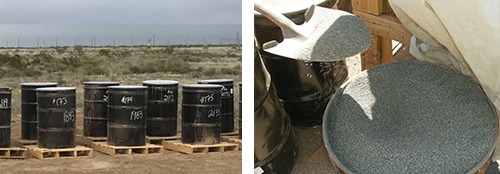 Back to News
Back to News
January 4, 2018
Five Tips for Shooting Ranges Onsite Lead Waste Management
The management of hazardous waste produced on your firearms range includes specific compliance measures that need to be taken. But even if your waste is considered non-hazardous for purposes of off-site disposal, as I discussed in my previous article Lead-Containing Material Disposal Considerations for Firearms Ranges, it is still important to ensure that this waste is managed appropriately onsite. Following are five tips for improving your onsite lead waste management.
 Training — Appropriate training for you and your staff in the proper handling of your onsite lead waste is critical. The amount and type of training will vary depending upon the person/task(s) being performed. For example, the person working the cash register does not necessarily need the same level of training as the person tasked with swapping out lead-contaminated range filters. A good start for employee training includes:
Training — Appropriate training for you and your staff in the proper handling of your onsite lead waste is critical. The amount and type of training will vary depending upon the person/task(s) being performed. For example, the person working the cash register does not necessarily need the same level of training as the person tasked with swapping out lead-contaminated range filters. A good start for employee training includes:
- The 40-hour version of OSHA’s Hazardous Waste Operations and Emergency Response Standard (HAZWOPER) is the industry-standard in training. It is recommended for employees directly interacting with lead waste and lead environments.
- Lead awareness training (29 CFR § 1926.62), which can serve as a general training for all onsite employees.
- Hazardous Communications (Haz-Com) training. This will ensure that your employees understand how the hazardous nature of onsite materials is communicated and how to use that information to best manage those materials. This training will allow for improved knowledge and management of all onsite chemicals/materials and is a great basic level of training for all employees.
 Containerization — It is important to use the proper containers for storage of your range waste. Eventually, this waste will be transported off-site to an appropriate disposal facility. As such, the best method of storage is to have the waste stored in readily transportable containers. For most ranges, DOT compliant drums and cubic-yard (CY) boxes work best.
Containerization — It is important to use the proper containers for storage of your range waste. Eventually, this waste will be transported off-site to an appropriate disposal facility. As such, the best method of storage is to have the waste stored in readily transportable containers. For most ranges, DOT compliant drums and cubic-yard (CY) boxes work best. Labeling — It is important to properly label your waste. Hazardous waste regulations work to ensure that waste is being managed appropriately, and labeling is part of that management for which you are responsible. Common hazardous waste stickers can be found online and should suffice for your needs. Additionally, it is important to label non-hazardous waste.
Labeling — It is important to properly label your waste. Hazardous waste regulations work to ensure that waste is being managed appropriately, and labeling is part of that management for which you are responsible. Common hazardous waste stickers can be found online and should suffice for your needs. Additionally, it is important to label non-hazardous waste.- Inspection — The amount of time it takes from generation of the waste to the moment it leaves the site can often be measured in weeks, not days. It is recommended (required for hazardous) that you regularly inspect your waste. Is it being protected from the elements? Is it leaking? Are the containers showing evidence of puncture, damage, deformation or other such defect? It is also recommended that you keep a log of your inspections.
- Documentation — The importance of documentation can never be stressed enough. The overall goal of the cradle-to-grave documentation process is to be able to tell the story of the lifetime of that waste. Part of that time is spent on your site, and it is important to document how that time was spent. Documentation of items addressed in this section will often contain, but is not limited to:
- Health and safety program documentation
- Documentation pertaining to a medical monitoring program
- Employee training certifications (as part of the Health and Safety Plan)
- Container Inspection Forms
- A waste log documenting all waste, status of that waste and basic information such as type, date of generation, etc.
- Manifests for disposed waste
In addition to the above, you also want to implement a process for medical monitoring of you and your staff. This should include monitoring before, during and upon termination of their employment. Medical monitoring activities can include lead-specific testing such as blood lead measurements and respirator fitness exams, as well as more general monitoring such as chest X-rays, 50-pound lifting tests, etc. The CDC has a great resource here.
By putting these simple steps in place for your range, you will be able to show your due diligence in managing your onsite lead-containing waste. Have questions about your range and your current range management program? Visit www.nssf.org and click on the “Range” heading at the top of the page. There you’ll find numerous resources for today’s firearms range owners and operators, including NSSF’s Range Action Specialists, who can provide on-site consultations. For more information, contact Zach Snow, NSSF Director, Range Services, at zsnow@nssf.org.
About MT2
MT2 is a nationwide indoor and outdoor firearms range lead reclamation and maintenance contractor. It has served over 1,500 public and private firing ranges in all 50 states since 2000. MT2’s services include complete firing range maintenance and improvements, lead remediation services, lead reclamation, OSHA and environmental consulting, operational maintenance and range closure.
You may also be interested in: Lead-Containing Material Disposal Considerations for Firearms Ranges
Categories: BP Item, Featured, Ranges, Top Stories









